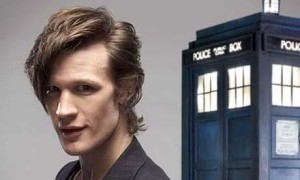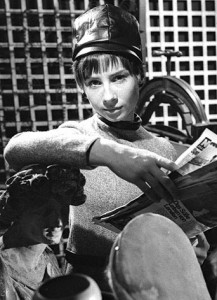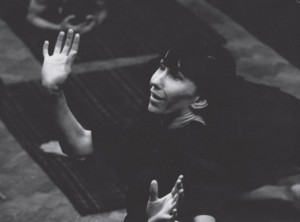Since April, the Matt Smith incarnation of the Doctor has been enjoying the benefits of a new Tardis. It’s not a new vehicle as such, more of a reconditioned one. His ride has been pimped.
However, since the very beginning it’s always been a rather pimptastic craft. When Xzibit and his streetwise crew of funky mechanics get down to a serious bit of ride-pimping in their MTV show, they often fit a fridge into the clapped out old banger that they’re doing up, in which the owner can put cans of beer or tubs of ice cream or, er, whole sides of beef.
Back in the William Hartnell days, the Tardis went one better than this – it contained a food machine. In one of the first episodes, dating right back to 1963, the Tardis crew are hungry, and one of them says they fancy bacon and eggs. We see the Doctor fiddling with some slightly improbable dials on a big metal thing, and out comes what looks like a chocolate Club biscuit. His earthly companions, Barbara and Ian, have a taste and – would you believe it? – it tastes just like bacon and eggs. In fact, one of them says that it’s as if one mouthful is bacon and the next is egg. The obvious comparison is the chewing gum meal in Charlie and the Chocolate Factory, but luckily in this case nobody ends up turning into a giant blueberry.
What’s interesting to me is that this relates to a popular idea in twentieth century science fiction – the idea that one day we’ll be able to dispense with all that food nonsense, and instead take our meals in the form of a convenient pill. In some cases, the idea of synthetic food is shown as being something scary. In the dystopian future of Soylent Green, for example, only the super rich can afford to eat actual food, whereas the rest of us have to eat weird little nutrient biscuit things made out of something unpleasant (which I won’t reveal here in case I spoil the ending). In many cases though, synthetic food is shown as something to look forward to. Ian and Barbara certainly seem to find their egg-and-bacon Club biscuit pretty yummy.
This made me start to think about what food was like when I was growing up in the 1970s. Current ideas about food being fresh, organic and natural were nowhere to be seen. The more unnatural the better. This was an age where powdered fruit juice, called Rise and Shine, was made out to be a convenient luxury, and where metallic aliens laughed at any sucker who bothered to peel and cut up actual potatoes when they wanted to make mash. Why bother, when you can pour a kettleful of boiling water on some beige granules and get a dish of vaguely potato-tasting crap in around ten seconds? Real ale was the preserve of bearded, folk-singing nutcases. Adverts showed us what modern, futuristic beer looked like: sterile lager, in a gleaming steel can, encased in a block of ice. Vimto, Tizer and Irn Bru – a soft drink that actually purported to be made out of metal – were far preferable to anything that actually tasted like fruit. Instant soup came in little cubes that you added to water and brought to the boil. It was advertised as ‘square shaped soup’ because, supposedly, it made a square meal. Then there was Angel Delight, a strange pudding made of milk and coloured powder, which wasn’t truly delightful and didn’t actually contain angels. The ads showed it served up in a kind of fat wine glass, which had to be moored with a piece of string to stop it floating away, so light and fluffy was the pudding it contained. I always used the think to myself that if Angel Delight really was lighter than air, surely it would squelch out of the chubby wine glass and float away in an unappetising gobbet, possibly ending up on the windscreen of a passenger jet and causing a terrible crash.
The excesses of the 1970s have largely disappeared, but some fake food still survives, and there’s a popular markets for things like Jammy Dodgers, Golden Nuggets and Pot Noodle. The hard truth is that the food industry will always want to make products like this, because they’ll always be more profitable than, say, an apple. The more ‘added value’ there is in a foodstuff (i.e. the more that’s been done to it), the more profit there is in it. There’s practically no added value in an apple, whereas there’s an absolute ton in, say, Dairylea Lunchables. Of course, the supermarkets try to get added value into apples by slicing them up and putting them in a plastic bag to go in our kids’ lunch boxes, but there’s not a lot more added value potential than that. That’s why there’ll always be more adverts on TV for processed crap than for fruit.
The problem is that the food industry’s interests are pretty much the exact opposite of ours. Generally speaking, the less that’s been done to a foodstuff, the greater its nutritional value. The healthiest way to eat an apple is straight from the tree. Even cutting it up and putting it in a plastic bag will deplete the vitamins and minerals it contains. Besides which, simple fresh food is usually delicious. A really fresh, tangy Cox’s Orange Pippin will always be nicer to eat than an apple-flavoured chew.
All of this means that the idea of aspiring to replace food with pills is appalling. It’s anti-life and it’s anti-pleasure. The Doctor should get rid of his food machine and replace it with a highly skilled robot chef that can makes actual meals from fresh ingredients.



